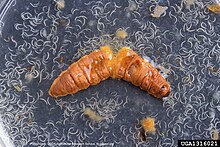| Heterorhabditis bacteriophora | |
|---|---|

| |
| Heterorhabditis bacteriophora nematodes emerging from a greater wax moth. | |
| Scientific classification | |
| Domain: | Eukaryota |
| Kingdom: | Animalia |
| Phylum: | Nematoda |
| Class: | Chromadorea |
| Order: | Rhabditida |
| Family: | Heterorhabditidae |
| Genus: | Heterorhabditis |
| Species: | H. bacteriophora
|
| Binomial name | |
| Heterorhabditis bacteriophora Poinar, 1976
| |
Heterorhabditis bacteriophora is a species of entomopathogenic nematode known commonly as beneficial nematodes. They are microscopic and are used in gardening as a form of biological pest control. They are used to control ants, fleas, moths, beetles, flies, weevils, and other pests.
These beneficial nematodes enter target insect larva via mouth, anus or respiratory openings and starts to feed. To reproduce the nematodes release Photorhabdus bacteria from their digestive tract. The bacteria rapidly multiply in the target insect larva and kill it. The nematodes then use the larva cadaver to grow and reproduce.[1]
- ^ "Natural pest control with beneficial nematodes". Gardeninsects.com. Retrieved 2011-08-26.